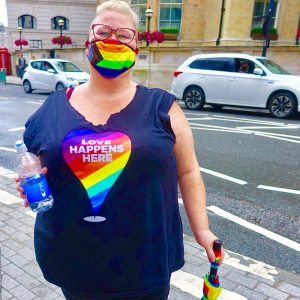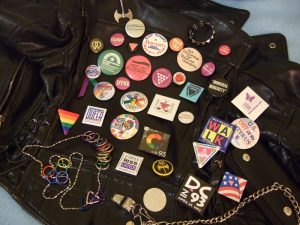Happy #LGBTHM22 everyone! If you have picked up some of the books in our library displays, you might have noticed that a number of them are about queer histories. The way these stories are told has changed over time, but a plethora of gender identities and expressions, and experiences of sexuality and identity, are a constant of human history. In other words, queer people have always existed. History books like Sapphistries or The Hidden Case of Ewan Forbes depend on a wide array of sources, particularly what historians call primary sources, which are materials–diaries, documents, drawings, and more–made by someone who lived through or experienced a particular time, place or event. Historians often think of primary sources as texts but they aren’t always–comics in a zine like Not Trans Enough could be something historians use to understand the lives and experiences of trans people in the 2010s, in the same way that a Pride flag facemask will be a primary source to a scholar looking back on the 2020s.

Primary sources are incredible important for queer histories. They allow students and scholars to explore what life was like for a particular person or group of people. Reading about the experiences of queer people in the past can help create a feeling of belonging or community, for LGTBQ+ researchers today, creating the opportunity identify with the experiences or emotions to those of someone who lived in the past. For all of those reasons–community, curiosity, and research–this month (and let’s be honest, all the rest of the year too) is a great time explore an archive of LGBQ+ History.
So where do you start?
An important place to begin, as this essay by Mollie Clark indicates, is with language. The terminology of queer history has changed and evolved over time, so especially if you are interested in pre-twentieth century stories, it is important to do some preliminary research before you begin. Most archives with a focus on histories of gender and sexuality are aware of the need to translate between the past and the present and provide you with some guidance on what their collection contains and how to make the most of it. It may be boring and frustrating to read the fine print when you want to dive straight into the sources, but having the time and patience to orient yourself to your surroundings usually pays off.
This is because historical documents reflect the particular background, experience, and education of the person who produced them. In turn, your positionality as a researcher (your background, experience, and education) affects how and what you search for. Expectations can shape findings: if a researcher goes to an archive with a predetermined view that ‘there’s nothing to see here because LGTBQ+ people weren’t visible back then’, then they may inadvertently confirm that in their research. Patience, an open mind, and a sense of adventure can be very helpful.
As you explore, we especially recommend checking out the following databases:
- Gender Identity and Social Change is an archive of primary source materials for the study of the history of gender, focusing particularly on the histories of men’s and women’s movements in the twentieth century. We recommend exploring the thematic areas of the collection to get a sense of what it has to offer!
- Sex and Sexuality is an archive of primary source material relating to gender identity, sexuality, and sexual behaviours, focusing on material from the nineteenth twentieth centuries including personal accounts and papers such as Anne Lister’s diaries, professional research in sexology by figures like Alfred Kinsey, and the papers of advocacy organisations such as the Gay Liberation front. Because it’s such a wide-ranging archive, we encourage you to take a tour of the collection to start your explorations.

Both databases are found in the library’s Adam Matthew Explorer collection, which holds a huge range of primary sources. In addition to our library’s collections, many other libraries and institutions are increasingly attempting to make queer stories more widely known and available, often through digital archives. Here are a few that have inspired us this month:
- The May Bragdon diaries the diaries and photographs documenting the lives, loves, and friendships of an amazing group of women in late nineteenth and early twentieth century New York. Lyndsey Jenkin’s wonderful article on the collection and its importance for queer history here.
- The British Library oral history collection contains a number of collections specifically having to do with LGTBQ+ histories, such as the Hall-Carpenter oral history archive and the Millthorpe Project: Interviews with Gay, Lesbian, Bisexual, and Transgender Trade Unionists. You can access clips from these archives on the British Library website and get the full versions by visiting the British library.
If you have explored the archives above or have found others, we’d love to hear about your experiences. Please leave a comment on this post or connect with us on social media.
And finally…
Student researchers often focus very heavily on diaries as important sources for understanding personal experiences. Hopefully an exploration of the archives mentioned above will add letters, photographs and oral histories to the repertoire of sources to search for when investigating the past. We encourage you to ask for help from your library as you research queer histories, this month and beyond. Your subject librarian can help you by suggesting ways to search the library collection and make the most of what we have to offer, and if you are working on a dissertation or assignment, our writing development service can help you showcase your findings. If you want to be inspired by the work of fellow students, we encourage you to check out student work in queer studies on our dissertation showcase.